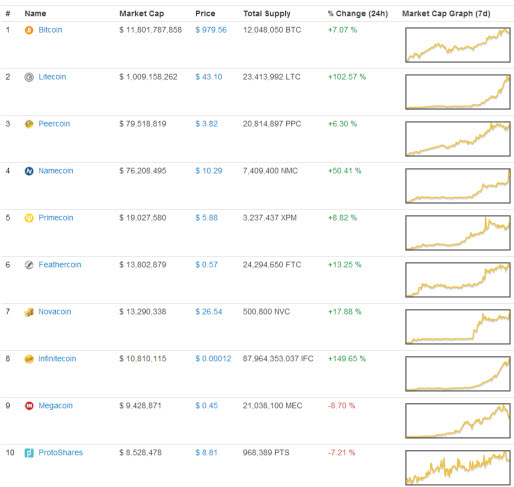Not just Bitcoin: How will multiple digital currencies compete, succeed, and fail?
Bitcoin surpassing a valuation of $1,000 yesterday is a real landmark, giving the currency a market capitalization of almost $12 billion and 75-fold growth in value this year.
However Bitcoin is not the only digital currency, simply the most prominent. As Bitcoin’s value has soared, partly driven by a positive response from Senate committees last week, participants have looked further afield to see whether there may be other alternatives that have not risen by so much already.
The second most prominent currency is Litecoin, with a market capitalization of over $1 billion. After that Peercoin and Namecoin currently have capitalizations of close to $80 million, followed by a number of others from $20 million and down in a long tail, with the 23rd ranked currency, Goldcoin, still valued at over $1 million.
Litecoin is over 10 times its value from just 10 days ago, with Peercoin growing 4-fold and Namecoin 12-fold in value over the same period.
The following chart is a snapshot from Coinmarketcap, which provides real-time information on digital currencies. The table shows the largest currencies by market cap, with the chart on the right hand side showing growth over the last 90 days.

There are a number of important factors to consider in this proliferation of digital currencies.
* Network effects apply very strongly to global currencies. If digital currencies become a prominent means of exchange, there will absolutely be one dominant currency. There is place for several other players to have a real presence, however they will likely be far behind the leader.
* Bitcoin is succeeding partly because it has been very thoroughly tested in its few years of existence. People now trust that the algorithms and architecture that underlie Bitcoin are solid. However other currencies have been not nearly as well tested. It is possible that some of others in existence today are flawed. If that is discovered then all digital currencies would be massively impacted, however people would quickly distinguish between well-tested currencies and newcomers.
* As I noted in my recent piece on the death of cash by the hand of digital currencies, it is inevitable that Bitcoin values will be highly volatile for the foreseeable future. It is difficult to see a timeframe in which its value will stabilize relative to fiat currencies. That volatility will be amplified for other digital currencies, which are largely being used as alternates to Bitcoin. Positive or negative sentiment on the outlook for Bitcoin will be even stronger for other currencies.
* The early mover advantage for Bitcoin is very strong. What will be very interesting to see is how the currencies can differentiate themselves, in their structure or the architecture of how transactions are made. Namecoin is fundamentally different from the others in that it is not just a currency, but also a decentralized Domain Name System, meaning that it is beyond the control of ICANN, the international (though US-dominated) organization that oversees the Internet’s domain system.
* There will unquestionably be further proliferation in digital currencies, followed by massive consolidation in coming years. The degree to which that happens will depend on how well currencies can differentiate themselves, and also the potential for communities – regional or otherwise – to prefer particular currencies.
Regulation is the factor that could, not kill, but strongly limit digital currencies’ growth. However I believe it is inevitable that digital currencies, which could be dominated by Bitcoin or potentially a successor, will play a prominent role in financial transactions in the future.
One of the very interesting issues is how these multiple digital currencies will play out against each other.
Anything outside Bitcoin is at this point extremely risky (that is, far riskier than even Bitcoin). Yet there may be some very, very big winners too.
